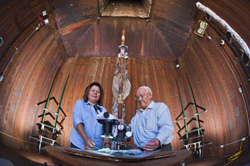ALBUQUERQUE, N.M. — Walt Gill of Sandia National Laboratories’ Fire & Aerosol Sciences Department calls it a pancake — a disk more than a foot in diameter covered with what looks like the debris you’d scrape off a particularly messy barbecue grill. It’s actually a crunchy, baked-on mixture of aluminum, aluminum oxide, carbon and other chemicals that coats everything after a rocket propellant fire.
The gritty material is part of a study Sandia is doing under a three-year contract with the Jet Propulsion Laboratory (JPL), California Institute of Technology, with funding from NASA.
The propellant fire modeling project began in February and expands beyond the risk analyses Sandia already does for the U.S. Department of Energy (DOE). A presidential directive requires the DOE to assess the risk to the public of launching NASA space missions that carry radioactive material used to make thermoelectrical power. The DOE contracts with Sandia for those assessments.
A propellant fire is one of the major risks in launching space missions with radioactive material, said Ron Lipinski, Sandia team leader for the risk analysis.
Lipinski’s team needs information to assess overall risks. This year JPL teamed with Sandia’s fire sciences group to provide technical information on propellant fires for a report on potential accidents that could occur during launch. JPL is managing the activity.
Gill said the key to Sandia’s contribution is advanced computer modeling focused on characteristics of propellant fires.
“It would be a combination of experimental data and model results that would work together to give them the information they need,” he said.
The report, termed a databook, becomes the foundation for assessing risk. “Sandia is able to use our broad range of expertise, from experiments with various environments to modeling to our risk analysis process and safety analysis,” Lipinski said.
The work builds on tools the Labs created in nuclear weapons programs, including data from propellant fires it has studied since the 1970s, Gill said. “What Sandia has contributed that’s original into this whole mix is the idea of putting test data together with multi-physics high-fidelity models and looking at them as one piece,” he said.
Coupling experimental data with high-fidelity modeling in the databook hasn’t been tried before, so researchers in the Labs’ Advanced Nuclear Fuel Cycle Technologies Department are building an interface between Sandia’s physics-based computational model of a fire environment and DOE’s radiological response model.
The interface is one of three parts of the project. The team also will update the computer model and add features to predict how things will behave in a propellant fire, then develop experimental data to validate the model. Tests will be done in the contract’s final year.
“That’s what sets Sandia apart,” Gill said. “We model, predict, experiment, compare. The Sandia way is we make the model first. … It’s like the scientific method; you come up with a hypothesis and test it.”
The complexity of this particular problem is increased by the makeup of rocket propellant, which has an oxidizer, a rubber binder and aluminum powder for fuel. Under conditions representing a launch accident, aluminum powder burns slowly, melts on the surface of the propellant and is lofted up into the flame, where it burns like droplets and leaves gritty deposits on everything, Gill said.
The risk assessment examines the chemical makeup of the deposit and the temperatures in its layers, Gill said, hefting a large clear plastic bag of ashy-looking chunks. “This stuff comes from the aluminum that is burning in the flame. It hits the surface, goes out. It becomes really thick.”
Sandia is improving its overall model by focusing on models for the droplets and the coating’s chemical makeup.
It’s one thing to study a single aluminum droplet — there are numerous technical papers on that — but it’s another to study it in the complex physics of a propellant fire, said Anay Luketa of Fire & Aerosol Sciences.
“It’s very hard in a real propellant environment to capture the true dynamic behavior experimentally,” said Luketa, who has been studying a code called Rocstar, developed by the University of Illinois under a DOE-funded Advanced Simulation & Computing program. She’ll spend much of the summer seeing if Rocstar will meet the project’s needs. Sandia also has its own fire modeling code: Fuego, Spanish for fire. Gill said the team wants to run both programs and compare them.
The team can base its study of how the materials respond on current weapons work involving melting and burning aluminum, Gill said.
Sandia researcher Bill Erikson said the model has to capture convection, or the flow of hot gases over a surface; thermal radiation transfer; and the thermal loading associated with accumulating grit with its varying particle sizes and distribution.
Burning aluminum particles are extremely hot, reaching about 4,940 degrees Fahrenheit or more, Erikson said. As they radiate out, countless tiny, very hot particles slam into surfaces, leaving the gritty chemical buildup.
Sandia researchers have designed models for the heat transfer occurring with the deposition, and they’ve added changeable properties to account for growing deposit layers, Erikson said. Still, he said, the models don’t yet capture such things as chemical reactions where molten aluminum hits other surfaces.
Eventually, the team’s work will be added to large codes. “It’s one thing to understand; it’s another thing to make them predict something,” Gill said. “This is the result of a lot of work by a lot of people to give us these big machines and these big models.”
The team will validate the model by putting all the pieces together, such as through an accident scenario.
“You do the calculation, predict what it’s going to do and then you do the experiment and see if that’s what happened. You put everything in there, not just one part,” Gill said. “So these experiments can get large and complex. It might take six months to set up and a minute to do it.”

